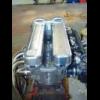If you are installing a new cam and the cam grinder gives you instructions for the initial start up, follow that. It is typical to have to keep the engine over 2000 for 10-20 minutes with the transmission in neutral. After that, let the engine cool completely and check the head torque and valve clearances. Next take the car for a drive and try to load the engine (ie, use nearly full throttle) for brief bursts of acceleration. Don't be afraid to get up to 5000 rpm. Be sure to get on and off the throttle, it is sustained steady speed you don't want.Try to drive for 20-50 miles like this. Let the car cool completely, check head torque, check valve clearances, change the oil. Now drive the car normally, except try to drive the car at at varying speeds, not steady state. Don't be afraid to use full throttle and maximum rpm, just back right off when you get there. Give the engine a full tune up, service, oil & filter change, and drive happily ever after.
The big mistake people make is trying to baby the engine the first few thousand miles. The cylinder walls glaze over and the valves fail to seal fully. This has been well documented. So why do the manufactures recommend babying the engine? Because they feel it is too difficult to explain the correct technique to customers and they don't want people to do sustained high speed driving. Sustained high speeds will damage a brand new engine. Anybody with enough mechanical skill to build their own engine is capable of understanding that sustained high speed driving is different from brief spurts of full throttle driving. Brief spurts of heavy throttle is what seats the valves and beds in the rings. The engine requires cylinder pressure to make this happen.
The above break in procedure comes direct from Honda engine engineers, off the record of course.
Now once you break in your engine, don't forget to give it that occasional Italian tune-up!
Edited by crock, 01 March 2013 - 06:45 AM.



















